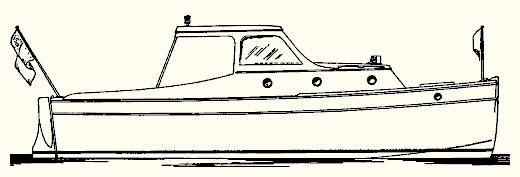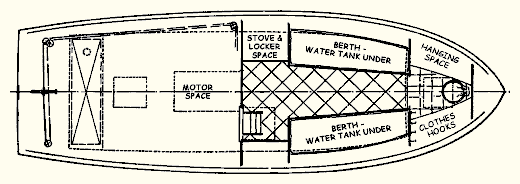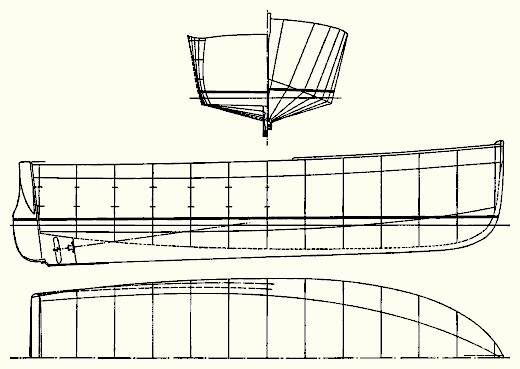

Ben Peck is the kind of motor cruiser many of my long list of correspondents want. Not a big boat but not a cockleshell; not too heavy but able, shipshape and up-to-date but without too much streamlining; inexpensive as to first cost and maintenance but withal much of a staunch little ship -- in other words, a small practical cruiser. And may its number ever increase!

This month's design is a trunk cabin model with cabin sides of modest height, reasonable crown to the cabin top beams, and a short pilot house and standing top. There is a foot-wide deck between rail and cabin house providing a safe foot-hold for moving forward and aft on deck. The cockpit is nearly 10 feet long by something over 6 feet wide; it is self-bailing and stands 14 inches above the L.W.L. There is full 6 feet of headroom under the pilot house top. A box protrudes 9 inches above the floor over the motor. It would be all right to raise this height enough so box can be used for seat or table.
Ben Peck is 24 feet 10 inches in overall length; 24 feet on the water line; 8 feet 6 inches in breadth; and has an extreme draft of 2 feet 2 inches. The freeboard at the bow is 4 feet 2 1/2 inches and at the stern, 3 feet 3 inches.

The cabin is laid out for two. Two good sized berths, water closet forward, galley things aft. And a surprising amount of room for so small a boat. The headroom under the house top beams is 5 feet 9 inches and under the companion slide a few inches more. Ventilation is provided by the 5-inch diameter port lights and by the forward hatch and companionway opening.

The sections below the chines show generous deadrise which is carried all the way to the stern. The sections above the corner of the chines have sufficient flare to throw spray aside; all sections forward of station 6 arc straight and those abaft station 6 are moulded as shown. While the moulding of the sections is slight it nevertheless removes the boxiness of high-sided straight sections through the after part of the hull, especially the stern transom. All sections below the chines are straight. The bottom of the keel extends in a straight line from station 2 to station 11. From this point a bronze shoe extends aft to support the heel of the rudder. The propeller is especially well protected by this arrangement. The stem transom is flat athwartships. This simplifies the construction of this part of the boat. The rudder is outside the stern and is hung on the usual pintles and gudgeons; the heel being supported by a strap and suitable pin into the after end of the shoe. The outside rudder breaks up the flatness of the stem to a great degree. The lines were drawn to produce an easily driven hull at speeds up to 10 real miles an hour and this, by-the-way, is an excellent rate of speed for a small cruising boat. I would suggest a motor like the Red Wing 25-45 h.p. Thorobred which is a four cylinder model having a cylinder displacement of 186 cubic inches. At approximately 1,300 r.p.m. the speed of this latest of MoToR BoatinG's family of practical boats will be somewhat over 10 miles an hour. I would advise against putting much more power than this in Ben Peck.